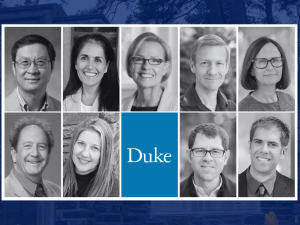Visual Arts Helping to Create a More Empathetic and Insightful Engineer

Annika Allado is a Mechanical Engineering major who is also pursuing a minor in Visual Arts with the Department of Art, Art History and Visual Studies (AAHVS).
An international student from the Philippines, she came to Duke with the goal of focusing on the intersection of art and engineering, and she gained a taste of the design process as a first-year student in Engineering Design and Technical Communication (EGR101).
In the introductory course, Allado was part of a team tasked with building a portable handwashing station for the remote Aeta community in the Philippines, a project that was obviously close to her heart. By the end of the semester, she knew she had found the right major.
Graduating in 2023, Allado has been heavily involved with Duke’s Innovation Co-Lab, working as a student design consultant with DesignHub. The position continues the work she enjoyed doing in EGR101, but on a more client-based scale.
As a consultant, each project helps her to explore new design constraints to satisfy the needs of different stakeholders and to hone in on the concepts learned in her classes.
Sketching and concept design have always been her passions. Her first year at Duke, she also took a visual arts class and found it provided more breadth to her STEM classwork.
The Benenson Award winner spent this summer at IED Madrid, learning the fundamentals of product branding, design and fashion architecture — skills she plans to use during her final semester on a project that combines fashion and engineering.
We sat down with Allado to talk about why she added art to her STEM studies and her postcollege plans.
Why is it important to include visual arts courses in your studies at Duke when your career path is focused on mechanical engineering?
My visual arts courses challenge me to think differently and creatively, which is extremely important in brainstorming and innovation. In my project-based courses, this has helped me when having to conceptualize different solutions.
It’s easier for engineers to think about the possibilities of the right answers and the ideas that will work because they are supported by data-driven evidence and the right governing principles.
Arts classes are the complete opposite. I’m given the liberty and autonomy to create and to break the rules, challenge the status quo and present what I, as an individual, believe in. I find this extremely liberating and stimulating.
The knowledge and understanding of scientific evidence and engineering fundamentals, when combined with the liberties, techniques and storytelling elements of visual arts, are what I believe ultimately drive innovation and human-centered design.
Have you found that your visual arts courses benefit your engineering studies?
Yes. A large part of the product design work and communication in my engineering classes boils down to visualization.
When I’m presenting an idea, 80% of the time I sketch it. It’s my visual arts background that helps me to better communicate ideas while also assisting me in CAD (computer-aided design) modeling — a large chunk of what we do as mechanical engineers.
Because I can picture in my head how to build and sculpt a design, I can model it on my computer screen. But more importantly, my background in arts has helped me become a more empathetic and insightful engineer.
Artists create as a means of storytelling. They present an idea or a concept to convey personal and societal feelings through visual aids. The artistic process requires a deep observation of one’s surroundings and society, which is also essential to human-centered design as an engineer.
The best designs are ones that directly and thoughtfully address the needs of the consumer.
Have your engineering studies also benefitted your arts courses?
I think my STEM background really opens my eyes to new patterns and intersections of art and engineering that I can potentially bring to my work.
Science naturally plays into what we as humans find visually and aesthetically appeasing, and my STEM courses have allowed me to gain a greater appreciation of the natural phenomena that often inspire artists.
For example, one of my favorite exhibitions is “Motion. Autos, Art, Architecture” at the Guggenheim Museum Bilbao. It explores the intersection of automobile structures with the world of painting, sculpture and architecture, while considering the affinities between technology and art.
My favorite piece in the collection, “Bird in Space” by Constantin Brancusi, mimics the notion of a bird’s flight but also resembles a lot of aerodynamic structures we see in rockets and cars.
After graduation, what does your next chapter look like?
After graduation, I plan to pursue a career in product design engineering. I believe it’s my best path to gain technical industry experience while also using the ideation techniques and visualization skills acquired from my visual arts education at Duke.
However, I don’t plan on being an engineer forever. I want to go to graduate school to focus more on industrial design or a course that combines both arts and engineering since I feel that there is so much more theory and practice that I need to learn.
My inspirations are the fashion designer Iris Van Herpen and Neri Oxman, who is an artist working in the MIT Media Lab. I hope to carve a similar path that fuses the visual arts with science to make the most of existing and future technology — without forgetting the importance of sustainability.
I do know that I want to open my own design house one day. And I’d like to be remembered for exploring the coexistence of art and engineering, in whatever form that looks like.




